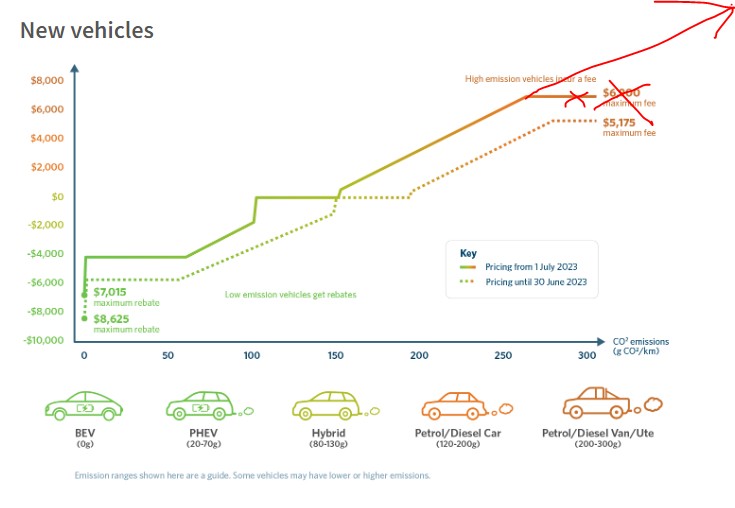On the Clean Car discount changes, I feel the outcome was largly in line with what I expected. There was no way we could afford to keep paying Rebates on stuff burning 5+ L/100km in 2023.
That said, if I was writing the policy I would have done some stuff differently:
- Got rid of the clean car fee cap. Just have it uncapped. Would force the media / opponents to pick an example and calculate the fee for it, rather than just putting a photo of a ranger and saying Up to $6,900 fee (when most rangers will pay a way lower fee).
- Tried as hard a possible not to cut the EV rebate. I don't feel it is the time to be reducing incentives for EV's yet.
- Cut the PHEV incentive - Unlike EV's, the emmision saving here are highly dependent on how they are operated.
- Tiered the PHEV incentive. Something like a Mini contryman with 40km of electric range (and bad fuel economy in hybrid mode), is quite a different offering to a Volvo V60 PHEV, with 91km of WLTP range.
- Put more eligibility requirements(in addition to the current sub $80k & 3 star safety):
- Require an immobilizer (Reduce the Aqua's reputation as the poster ram raid car) - dealers will retrofit as it is cheaper than the value of the rebate.
- For new EV's, PHEV's require a minimum traction battery warranty (say 8 years or 160,000km with 70% minimum retention) - basically the same as the federal minimum requirements in the USA - California goes further, 10 years or 240,000km. Will do a lot to alleviate buyer concerns, and I don't think we should be paying out thousands of rebates to any brand which doesn't back the battery to last a decent amount of time.
- Put an age cap on the used rebate. Perhaps 8 years (rounded to whole year of first registration numbers). Key issue here is the 2011 - 2013 leaf has a battery chemistry that is very prone to degradation. We should not be paying out $3500 to subsidize the import of a 2011 leaf with a battery at the cusp of starting to have cells fail. We want to be importing cars that have at least half their useful life left. Should note NZ already has ample supply of 24kWh leaf's as this was our dominant EV for many years, for those who really want one.
- Get rid of the hybrid-specific mobility vehicle exemption. Use a metric like g/km CO2 instead if you really want to crack to the media articles quoting Milner Mobility. I question the mobility category at all. Lots of industries are hurt by the clean car discount, but this is the price of reducing the emissions profile of vehicles entering our fleet.
- Introduce a new $100k price cap for vehicles with particular attributes:
- Pure Electric Vehicles with a large payload (say greater than 740kg) - Should capture Utes, Larger Cargo Van's, and larger electric passenger van's Frankly meeting the $80k price cap with these types of vehicles isn't going to be possible in the next couple of years for non china brands.
- Pure electric Vehicles with 8+ seats
- Pure Electric Vehicles with both AWD / 4wd & 200mm+ ground clearance (between axles, unladen) - No brand is yet to get an AWD EV under the $80k cap, and rareness of EV's with at least weak off road ability is quite a pain point. Hopefully EV's meeting my criteria will appear on the market soon.
- I would get rid of the half price clean car fees for used imports, and charge both new and used at full price (but keep the half sized rebates. I don't see why somebody importing say a a Dodge challenger, or a 2020 toyota prado, should get half price emissions fees vs somebody buying a new ford mustang V8, or Prado.
Unrelated to the clean car discount, but I would also introduce an include Pure EV's under 4250kg as light vehicles (so no need for COF and 90km/h speed limit). Larger petrol / diesel vehicles are already approaching 3,500kg GVM (Ranger v6 wiltrak is 3350kg, Hiace ZX Panel Van 3500kg, nissan Patrol Y62 3500kg GVM). Any electric equivalents are going to be 300 - 500kg heavier. If we want electric versions of these style of vehicles to be viable in NZ, we need to allow them extra weight. Especially pressing with van's already Toyota NZ doesn't bother to offer 12 seat passenger version of the hiace likely due to this reason, instead offering a 10 seat version (12 seat is available in Aust. 3710kg & 3720kg GVM for each of the two versions)
I picked 4,250kg as this is where the UK has moved their Drivers licensing limit to for alternative fuel vehicles, so there are a good number of van's optimized for that threshold. Note that in NZ on a full car license one can already drive up to 6000kg, so that is not an issue here, and I don't propose to change that limit. On safety, the light / heavy threshold is just arbitrary anyway, and one can drive a 3500kg car and 3500kg trailer on Just WOF's anyway (class 2 licence needed), and I would expect a 4250kg van to be dynamically a lot bigger than any rig with a big trailer. Note that really heavy American stuff like the Hummer EV is so heavy it would still miss the 4250kg GVM threshold.



